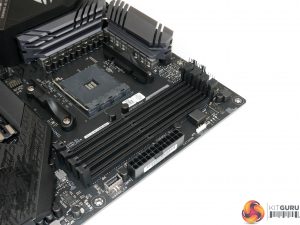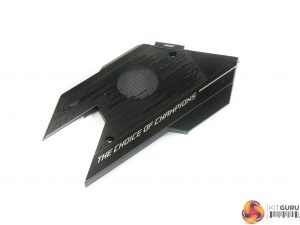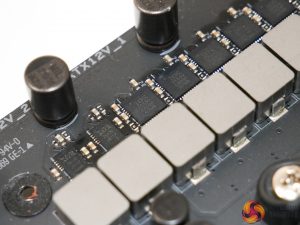The ASUS ROG STRIX X570-E Gaming takes the usual styling for ASUS’ premium style of gaming motherboards. The PCB and slots are primarily dark black with shades of grey acting as contrast.
Arguably the most noticeable feature of the motherboard, ASUS deploys an ROG-branded rear IO cover that features a reflective panel with STRIX text on it. Personally, I like the look of this. I also like the look of the STRIX text on the rear of the motherboard PCB, even though it is utterly pointless and simply wastes manufacturing costs as it will always be hidden by the motherboard tray inside a chassis.
ASUS provides a couple of RGB lighting zones to complement the plentiful supply of headers. The RGB lighting is subtle, but colours are good, and the overall appearance is smooth.
Four single-latch DIMM slots provide support for up to 128GB of DDR4 memory. Keeping the black colouring consistent between all DIMM slots is a feature that I like. I don’t see the omission of steel reinforced ‘SafeSlot’ connectors for the DIMM slots as a negative, either.
Close to the DIMM slots is the internal USB 3.2 Gen 2 Type-C header. ASUS also deploys an addressable RGB header in this location, positioning it next to the 24-pin power connector.
I like the inclusion of four POST LEDs in an easy-to-view location. Users can quickly see if their boot device, VGA, CPU, or DRAM is POSTing correctly. This is good to see for a platform that is as immature as X570 is at this current time.
8-pin plus 4-pin power connectors are found in their usual location on the motherboard’s top edge. ASUS reinforces the 8-pin connector with a steel casing, which is realistically unnecessary, even when accounting for the force of pulling out the stiff 8-pin cable connector.
Along this top edge is another RGB header – this time 4-pin in design. ASUS includes three 4-pin fan headers to service the CPU area – ideal for dual-fan AIO users.
I would have liked to see some form of onboard power and reset buttons in addition to voltage monitoring points in this region. Unfortunately, they do not exist on this motherboard at all. That’s disappointing for a premium £300 offering that will target users who are savvy with overclocking and have an interest in true system monitoring.
ASUS provides eight SATA 6Gbps ports, which is the same number we see deployed by ASRock’s competing X570 Taichi. Eight ports on a board of this calibre is ideal as it gives users plenty of flexibility for cheaper (and slower) SATA storage devices.
Also worth noting is the fact that none of the SATA lanes share bandwidth with the M.2 connectors. This is ideal as it allows all eight ports to be used simultaneously.
Along the bottom edge, ASUS deploys a pair of USB 2.0 headers. This is ideal and still preferable to a single header thanks to proliferation via peripherals and cooling hardware. The single 5Gbps internal USB 3.0 header is located along the board’s bottom edge in a region that may be difficult to reach for some case designs. Just including the one USB 3.0 header is slightly limiting, especially as ASUS’ own ROG case requires two of the connectors.
I am particularly pleased to see the two-digit debug LED being provided by ASUS. Even at this price point, the ever-useful display is one of the first features to be culled when aiming for a specific price target. It is good to see three 4-pin fan headers positioned on the bottom edge where cables can be tucked away easily. The same goes for the pair of RGB headers, one of which is the preferred addressable type.
The usual affair of front panel cable connectors and the audio header round out the noteworthy features located down the bottom. There is no Thunderbolt internal header, however. Though I’d say this is unlikely to be a problem for most of this motherboard’s audience.
ASUS provides a pair of M.2 connectors sat beneath individual metal heatsinks. Both slots PCIe 4.0 x4 and SATA 6Gbps drives up to 110mm in length. There’s no bandwidth switching between the M.2 connectors and PCIe slots or SATA ports. That’s ideal as it allows users to deploy the full cohort of M.2 SSDs and SATA drives without hassle.
It is disappointing to see ASUS providing only two M.2 slots when competitors at this price point generally deploy three. That additional M.2 connector on competitors such as ASRock’s X570 Taichi simply provides extra flexibility, as one should expect on a £300 product.
Also disappointing is the needless complexity involved in installing an M.2 SSD. Despite both the heatsinks being separate from the chipset heatsink and shroud, a user is forced to remove the RGB-equipped board cover to access the necessary screws.
The same criticism that we dealt ASRock with the X570 Taichi is relevant here; instead of a user spotting a deal on a shiny new M.2 SSD and having it installed in their already-built system within 2-3 minutes, one has to remove the expansion devices, unscrew the motherboard shroud, remove the M.2 heatsink, install the SSD, re-install the heatsink, refit the shroud, and then re-install expansion cards. That makes a 2-3-minute job a 15+ minute one. Ramp the time requirement up significantly if your graphics card is fitted with an AIO liquid cooler or in a full-custom water loop.
What’s wrong with simply repositioning the screw or providing a cut out in the shroud to avoid such a needless waste of a user’s time?
You get the usual set of PCIe expansion slots deployed as x16/x0 or x8/x8 for the primary steel-reinforced connectors. That bottom full-length slots operates at PCIe Gen 4 x4 from the X570 chipset and shares its bandwidth with the x1 slot above it.
Expansion slot spacing is ideal for a modern mainstream motherboard with Crossfire and SLI support. You can use 2.5- or 3-slot graphics cards while maintaining access to the other primary full-length connector.
ASUS’ audio system is based around the SupremeFX S1220A audio codec. A metal EMI shield covers the codec to minimise interference. Also provided is a pair of operational amplifiers and a bank of Nichicon audio capacitors.
The use of an integrated IO shield is very much welcomed on a premium motherboard of this calibre. From left to right, you get DisplayPort 1.2 and HDMI outputs for use with an APU. The HDMI connector is version 2.0b and supports 4K60 with a relevant APU.
The BIOS flashback button is marked for use with a specific USB port. BIOS Flashback is another good feature to see on this calibre of motherboard as it aids system resilience against BIOS problems and allows for easier updates with a future AM4 chip. A total of eight USB ports is available on the rear IO, all of which operate at 3.2 Gen 2 10Gbps speed. It is highly impressive to see ASUS operating an all-10Gbps rear IO USB deployment.
Standard Ethernet is provided by an Intel I211-AT controller, while Intel is again used for the 802.11ax Wi-Fi 6 connectivity. One of this motherboard’s key features is the Realtek RTL8125 2.5Gbps Ethernet controller. The usual affair of audio connectors rounds out the rear IO.
There’s no rear clear CMOS button and that’s annoying, especially with the relative immaturity and frequency of BIOS updates for the X570 platform currently.
A total of seven 4-pin fan connectors is provided, four of which are close to the CPU socket. ASUS spreads out the headers fairly evenly, with three along the top edge, three along the bottom edge, and one in-board to cater for a rear chassis fan. A single 2-pin T-sensor header is found along the board’s bottom edge.
Four LED headers are provided, two of which are standard RGB and the other two are addressable connections. These are split between the top-right and bottom-right zones on the motherboard in locations that I would consider to be very good.
ASUS is using a proprietary ASP1405 PWM controller that is widely believed to be based on the highly competitive International Rectifiers IR35201 6+2 phase PWM chip. Clearly, 6+2 phases does not equal the 16 total phases for the X570-E and ASUS does not use PWM phase doublers.
ASUS’ 12+4 phase VRM is configured in 6+2-phase mode with each of the phases operating as a pair in parallel. So, you get twelve physical phases for the CPU but only six control phases. This has a latency benefit versus doublers but gives up some control granularity and accuracy.
With the use of International Rectifiers’ excellent IR3555 60A PowIR stages, the total current capacity for an AM4 CPU is 720A. Doubling or non-doubling, this is a superb VRM that should have absolutely no problems powering any current or future AM4 processors.
While the VRM heatsink is undeniably an aesthetics-first design, it is hard to criticise ASUS too much for that choice given the efficiency of the overkill power delivery system on the X570-E Gaming. I would have liked to see at least some effort to fin the heatsinks, but with an 8mm heatpipe connecting the two metal blocks, VRM temperatures should not be a concern.
ASUS’ 40mm chipset fan sits atop a metal cooling plate that features fins to dissipate heat from the X570 silicon. The fan is an open-rotor radial design that needs to force air across the fin stack in order to dissipate thermal energy effectively.
Incidental airflow for the radial fan is also likely to reach the M.2 SSDs nearby, which is likely one of the primary reasons for ASUS’ use of the plastic shroud.
Positioning of the chipset fan is not good, as the blower is sat directly beneath the venting location for a hot graphics card. Ingesting higher temperature air that has been expelled from a VGA cooler certainly isn’t ideal for chipset temperatures. MSI’s chipset cooling system on the MEG X570 ACE still looks to be superior, with that motherboard’s fan sitting further down the PCB.
 KitGuru KitGuru.net – Tech News | Hardware News | Hardware Reviews | IOS | Mobile | Gaming | Graphics Cards
KitGuru KitGuru.net – Tech News | Hardware News | Hardware Reviews | IOS | Mobile | Gaming | Graphics Cards



























